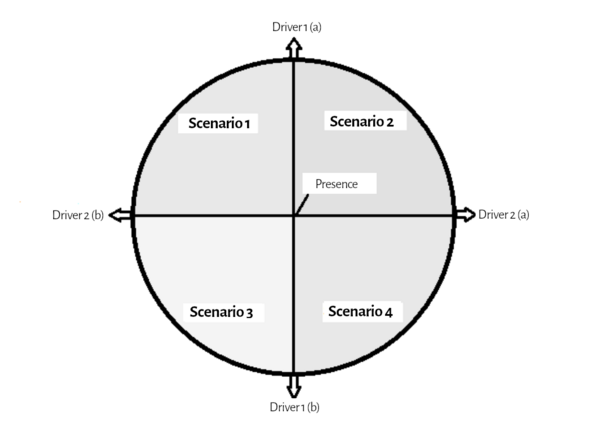- Participants are encouraged to form their own opinions on current and future developments.
- Examination of possible developments in society and the world of work
- Learning about the influencing factors and trends and the current situation in the world of work.
Contents
Steps
The Scenario Technique is a creative and complex method that proceeds in several phases. The participants develop four different scenarios on the topic of "The world of work in 20 years".
Creation of the scenarios
First, the group brainstorms factors and trends that have an influence on the and trends that have an influence on the world of work, such as, for example globalization, technical progress and digitalization, mobility, communication, the economic and social system, environmental protection, equal opportunities...
2. the key points are sorted according to their importance and are listed in givens and drivers - whose future role has not yet been determined (and to be explored during the task).
3. two essential drivers are selected, which should determine the scenarios. For this purpose, pairs of opposing factors are formulated, which are entered in the graph at the opposite points of the lines. Such as:
"no environmental protection" <--->"absolute environmental protection"
This results in the four different frameworks for the scenarios.
Work at scenarios
The participants form four small groups in which the scenarios are now developed. The working groups are supposed to take into account drivers and some of the givens. The scenario includes not only the respective fantasy future, but also the process of evolving into that future. The most descriptive scenario becomes most vivid when as many details as possible are worked out, including the effects for individual persons, but also for the world of work in general, for the economy economy, society and politics.
It can help the group to think up one or more protagonists and to depict the protagonists' environment, daily routine, everyday working life, etc.
The scenarios are presented to the other participants and discussed together. There are no limits to creativity when it comes to presenting the scenarios. It is up to the group if it prefers to read out, if a scene is acted out or pictures are painted and presented.
Reflection:
Guiding questions for the evaluative discussion can be, for example:
- Which future is desirable, which less so? Why?
- What should be done to develop a positive future and avoid a negative one?
- What options do you have for shaping this?
- What could others, such as politicians or companies, do for this?
Inspiration: Work under transformation
Digital Transformation in Adult Learning for Active Citizenship. An introduction into different aspects on how work is affected by the digital transformation.
Published in the frame of the project DIGIT-AL - Digital Transformation Adult Learning for Active Citizenship.

Tanja Berger
Published in German under the title: "Szenario-Methode. „Arbeits-Welt in 20 Jahren". Author: Tanja Berger. Shared under a CC-BY-SA 4.0 Creative Commons License by Bildung und Begegnen in Brandenburg at the online platform for civic education:
Variation
The topics are flexible. facilitators can also carry out the method taking into account topics/questions of their own choice. The content of the following steps is adapted accordingly.









